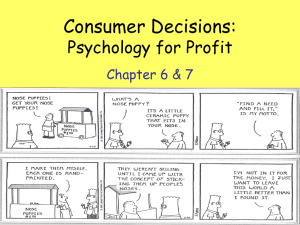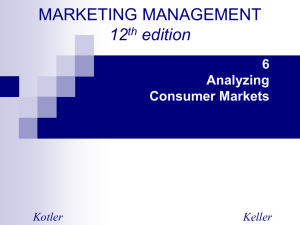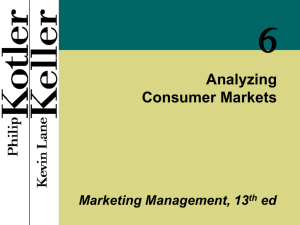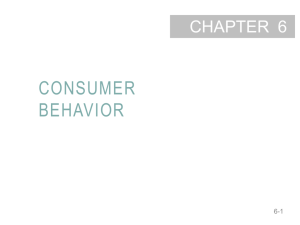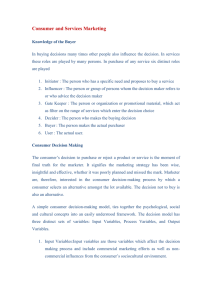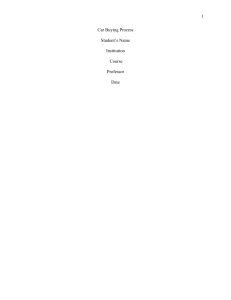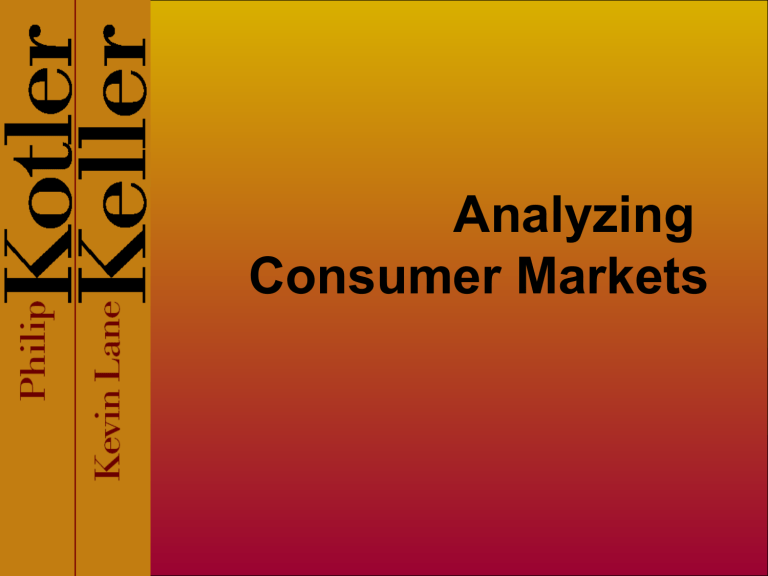
Analyzing Consumer Markets Sequence of the Lecture/Discussion • What Influences Consumer Behavior? • What major psychological processes influence consumer responses to the marketing program? • Consumer Buying Process What Influences Consumer Behavior? Cultural Cultural Factors Factors Social Social Factors Factors Personal Personal Factors Factors What Influences Consumer Behavior? Cultural Cultural Factors Factors What is Culture? Culture is the fundamental determinant of a person’s wants and behaviors acquired through socialization processes with family and other key institutions. Subcultures Nationalities Nationalities Religions Religions Racial Racial groups groups Geographic Geographic regions regions What Influences Consumer Behavior? Cultural Cultural Factors Factors Social Social Factors Factors Social Factors Reference groups Family Social Roles Statuses Reference Groups Reference groups are all the groups that have a direct (face to face) or indirect influence on attitudes or behavior. Reference groups influence members in at least three ways: • expose an individual to new behaviors and lifestyles • influence attitudes and self-concept • create pressures for conformity that may affect product and brand choices. •Groups having a direct influence are called Membership groups. •In Primary groups , people interact fairly continuously and informally, such as family, friends, neighbors, and coworkers. •People also belong to Secondary groups, such as religious, professional, and trade-union groups, which are more formal and require less continuous interaction. Reference Groups People are also influenced by groups to which they do not belong: •Aspirational groups are those a person hopes to join •Dissociative groups are those whose values or behavior an individual rejects. Where reference group influence is strong, marketers must determine how to reach and influence the group’s opinion leaders. Family FAMILY is the most important consumer buying organization in society and family members constitute the most influential primary reference group. There are two families in the buyer’s life: •The family of orientation consists of parents and siblings. From this, a person acquires an orientation toward religion, politics, and economics and a sense of personal ambition ,self-worth, and love. •A more direct influence on everyday buying behavior is the family of procreation , the person’s spouse and children. Roles and Status A Role consists of the activities a person is expected to perform. Each role in turn implies a Status. A senior vice president of marketing may be seen as having more status than a sales manager, and a sales manager may be seen as having more status than an office clerk. People choose products that reflect and communicate their role and their actual or desired status in society What Influences Consumer Behavior? Cultural Cultural Factors Factors Social Social Factors Factors Personal Personal Factors Factors Personal Factors Age Selfconcept Life cycle stage Lifestyle Occupation Values Wealth Personality Age and Life Cycle Stage • Our taste in food, clothes, furniture, and recreation is often related to our age. • It is also shaped by the family life cycle and the number, age and gender of people in the household at any point in time. The Family Life Cycle Occupation and Economic Circumstances • Occupation also influences consumption patterns. • Product and brand choice are also affected by economic circumstances: spendable income ,savings ,assets ,debts , borrowing power, and attitudes toward spending and saving. Personality and Self-concept • Personality. Each person has personality characteristics that influence his or her buying behavior. Personality means a set of distinguishing human psychological traits that lead to relatively consistent and enduring responses to environmental stimuli (including buying behavior). • Self Concept. It is how we view our selves. Consumers often choose and use brands that relate with their actual self-concept , although the match may instead be based on the consumer’s ideal self-concept (how we would like to view ourselves) or even on others’ self-concept(how we think others see us) Lifestyle and Values • A lifestyle is a person’s pattern of living in the world as expressed in activities, interests and opinions. It portrays the person interacting with his or her environment. • Values are the belief systems that underlie attitudes and behaviors. Values go much deeper than behavior or attitude and determine people’s choices and desires over the long term. Key Psychological Processes Motivation Perception Learning Memory Motivation • Freud’s Theory .Sigmund Freud assumed the psychological forces shaping people’s behavior are largely unconscious, and that a person cannot fully understand his or her own motivations. • Maslow’s Theory. Abraham Maslow explained that human needs are arranged in a hierarchy from most to least pressing —physiological needs, safety needs, social needs, esteem needs, and self-actualization. People will try to satisfy their most important need first and then try to satisfy the next most important. Maslow’s Hierarchy of Needs Motivation • Herzberg’s Theory. Frederick Herzberg developed a twofactor theory that distinguishes dissatisfiers (factors that cause dissatisfaction) from satisfiers (factors that cause satisfaction).The absence of dissatisfiers is not enough to motivate a purchase; satisfiers must be present. Herzberg’s theory has two implications. First, sellers should do their best to avoid dissatisfiers. Second, the seller should identify the major satisfiers or motivators of purchase in the market and then supply them. Herzberg’s Two-Factor Theory Perception is the process by which we select, organize, and interpret information inputs to create a meaningful picture of the world. It is the way to look at things , a way of regarding, understanding, or interpreting something in your own personal manner. People emerge with different perceptions of the same object because of three perceptual processes: •selective attention •selective distortion •selective retention • Selective Attention .Attention is the allocation of processing capacity to some stimulus. Voluntary attention is something purposeful; involuntary attention is grabbed by someone or something. • Selective Distortion is the tendency to interpret information in a way that fits our preconceptions. Consumers will often distort information according to prior brand and product beliefs and expectations. • Selective Retention causes us to remember good points about a product we like and forget good points about competing products. Learning and Memory • Learning induces changes in our behavior arising from experience. • Memory may be short term or long term. Short-term memory (STM) is a temporary and limited repository of information and Long-term memory (LTM) is a more permanent, essentially unlimited repository. All the information and experiences we encounter as we go through life can end up in our Long-term memory Consumer Buying Process Problem Recognition Information Search Evaluation Purchase Decision Postpurchase Behavior Consumer Buying Process • The buying process starts when the buyer recognizes a problem or need triggered by internal or external stimuli. With an internal stimulus, one of the person’s normal needs such as hunger, thirst ,etc rises . A need can also be aroused by an external stimulus such as a friend’s new car or a television ad for a vacation which inspires thoughts about the possibility of making a purchase. • The person then enters an information search: looking for reading material, phoning friends, going online, and visiting stores to learn about the product. Sources of Information Personal Commercial Public Experiential Consumer Buying Process • Evaluation. The consumer sees each product as a bundle of attributes with varying abilities to deliver the benefits. The attributes of interest to buyers vary by product. Consumers will pay the most attention to attributes that deliver the sought-after benefits. A Consumer’s Evaluation of Brand Beliefs About Laptops Stages between Evaluation of Alternatives and Purchase Consumer Buying Process • Purchase Decision. After Evaluation , two factors can intervene between the purchase intention and the purchase decision: • The attitudes of others. The influence of another person’s attitude depends on two things: • The intensity of the other person’s negative attitude toward our preferred alternative . • Our motivation to comply with the other person’s wishes. • Unanticipated situational factors or perceived risk may cause a person to change the purchase intention. Perceived Risk Functional Functional Physical Physical Financial Financial Social Social Psychological Psychological Time Time Consumer Buying Process • Postpurchase Behavior • Postpurchase Satisfaction. Satisfaction is a function of the closeness between expectations and the product’s perceived performance.If performance falls short of expectations, the consumer is disappointed; if it meets expectations, the consumer is satisfied; if it exceeds expectations, the consumer is delighted. • Postpurchase Actions .A satisfied consumer is more likely to purchase the product again and will also tend to say good things about the brand to others. Dissatisfied consumers may abandon or return the product. • Postpurchase Uses and Disposal How Customers Use and Dispose of Products Any Queries ?
